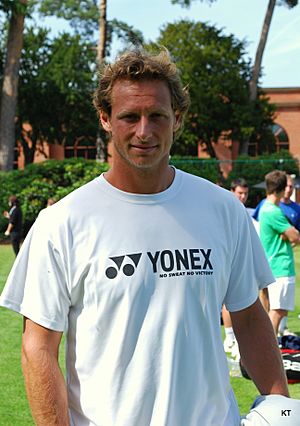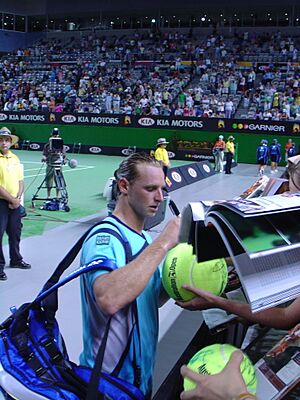David Nalbandian facts for kids

Nalbandian at Boodles 2011.
|
||||||||
| Full name | David Pablo Nalbandian | |||||||
|---|---|---|---|---|---|---|---|---|
| Country (sports) | ||||||||
| Residence | Unquillo, Argentina | |||||||
| Born | 1 January 1982 Unquillo, Argentina |
|||||||
| Height | 1.80 m (5 ft 11 in) | |||||||
| Turned pro | 2000 | |||||||
| Retired | 2013 | |||||||
| Plays | Right-handed (two-handed backhand) | |||||||
| Prize money | US$11,114,755 | |||||||
| Official website | davidnalbandian.com | |||||||
| Singles | ||||||||
| Career record | 383–192 (66.6%) | |||||||
| Career titles | 11 | |||||||
| Highest ranking | No. 3 (20 March 2006) | |||||||
| Grand Slam singles results | ||||||||
| Australian Open | SF (2006) | |||||||
| French Open | SF (2004, 2006) | |||||||
| Wimbledon | F (2002) | |||||||
| US Open | SF (2003) | |||||||
| Other tournaments | ||||||||
| Tour Finals | W (2005) | |||||||
| Olympic Games | 3R (2008) | |||||||
| Doubles | ||||||||
| Career record | 48–53 (47.6%) | |||||||
| Career titles | 0 | |||||||
| Highest ranking | No. 105 (5 October 2009) | |||||||
| Grand Slam doubles results | ||||||||
| Australian Open | 1R (2003) | |||||||
| French Open | 1R (2003) | |||||||
| Wimbledon | 2R (2003) | |||||||
| Team competitions | ||||||||
| Davis Cup | F (2006, 2008, 2011) | |||||||
|
Medal record
|
||||||||
David Pablo Nalbandian (born January 1, 1982) is a former professional tennis player from Argentina. He was known for his powerful shots and clever playing style. David reached his highest singles ranking of world No. 3 in March 2006. His tennis career lasted from 2000 to 2013.
Nalbandian was a runner-up at the 2002 Wimbledon Championships. He won 11 singles titles during his career. These included the important Tennis Masters Cup in 2005 and two Masters 1000 tournaments. He is the only Argentine man to reach the semifinals or better at all four major Grand Slam tournaments. He also reached the Wimbledon final, which is a big achievement. David was part of the Argentinian Davis Cup team that reached the finals in 2006, 2008, and 2011. He played right-handed and had a very strong two-handed backhand. Many people thought it was one of the best on the tour. After retiring from tennis, Nalbandian started competing in rally car racing.
Contents
- David Nalbandian's Early Life and Career Start
- Junior Tennis Success
- Becoming a Professional Player (2000–2002)
- Career Highlights and Challenges (2003–2004)
- Winning the Masters Cup (2005)
- Strong Performances and Injuries (2006)
- Amazing Comebacks and Titles (2007)
- Mixed Results and Davis Cup (2008)
- Injuries and Comebacks (2009–2011)
- Queen's Club Incident and Retirement (2012–2013)
- Life After Tennis
- David Nalbandian's Playing Style
- Images for kids
- See also
David Nalbandian's Early Life and Career Start
David Nalbandian was born in Unquillo, a small city in Argentina. His family has roots in both Armenia and Argentina. He became a professional tennis player when he was 18 years old.
Junior Tennis Success
As a junior player, David Nalbandian was ranked as high as No. 3 in the world in December 1998. He also reached No. 5 in doubles in 2000. A big moment in his junior career was winning the US Open boys' singles final. He beat future tennis legend Roger Federer in that match.
Becoming a Professional Player (2000–2002)
Nalbandian officially became a professional tennis player in 2000. By 2001, he was among the top 50 players in the ATP rankings. In 2002, he became the top-ranked Argentine and South American player. That year, he won two ATP titles. He also made it to the final of Wimbledon, a very famous tournament. He played against Lleyton Hewitt in the final but lost.
Career Highlights and Challenges (2003–2004)
In 2003, Nalbandian did not reach another major final. He had to deal with a stomach injury during Wimbledon. In 2004, he had his best result at the French Open, reaching the semifinals. He lost to Gastón Gaudio, who went on to win the tournament. Even though he didn't win any titles in 2004, he was a runner-up in two important tournaments: the Rome Masters and the Madrid Masters. He entered the top 5 for the first time in August 2004 and finished the year as the World No. 9 player.
Winning the Masters Cup (2005)
In 2005, Nalbandian reached the quarterfinals of the Australian Open, Wimbledon, and the U.S. Open. At Wimbledon, he made an amazing comeback. He was two sets down against Andy Murray but managed to win the match. He is the only player to ever beat Murray after being two sets behind.
His biggest win in 2005 was the Tennis Masters Cup. He became only the second Argentine player ever to win this big year-end tournament. He had to step in for another player, Andy Roddick. In the final, he played against the World No. 1, Roger Federer. Nalbandian won in a thrilling five-set match. He was the first player to win the Masters Cup without having won a Grand Slam or Masters Series title before.
Strong Performances and Injuries (2006)
In January 2006, Nalbandian reached the semifinals of the Australian Open. This meant he had reached the semifinals of all four Grand Slam tournaments in his career. He lost a tough five-set match to Marcos Baghdatis, even after being two sets up. In May, he won the Estoril Open in Portugal for the second time. A month later, he reached his second French Open semifinal. This was the only year he reached two Grand Slam semifinals. He had to stop playing in the French Open semifinal due to a stomach injury.
Later in 2006, Nalbandian helped Argentina reach the Davis Cup final. He won both of his singles matches in the final, but Argentina lost to Russia.
Amazing Comebacks and Titles (2007)
In 2007, Nalbandian's ranking dropped. He also had several injuries. However, his season changed when he won the 2007 Madrid Masters. He had an incredible run, beating the second seed Rafael Nadal, the third seed Novak Djokovic, and the top seed Roger Federer in a row. He was only the third player to beat the world's top three players in one tournament. After this win, his ranking jumped from No. 25 to No. 18.
He continued his great form at the 2007 Paris Masters. He again defeated Federer and then went on to win the tournament by beating Rafael Nadal in the final. This made him the first player to win the Madrid and Paris Masters back-to-back since Marat Safin in 2004. This success brought him back into the world's top 10, at No. 9.
Mixed Results and Davis Cup (2008)
Nalbandian started 2008 in the top 10. He won the Copa Telmex in Argentina, which moved him to World No. 8. He reached another final in Mexico but lost. He had some early exits from Grand Slam tournaments that year. However, his indoor season was successful. He won his ninth career title at the 2008 Stockholm Open. He also reached the finals of two other big tournaments.
To end the year, he played in the 2008 Davis Cup final for Argentina against Spain. He won his opening match, but Argentina lost the final.
Injuries and Comebacks (2009–2011)
Nalbandian started 2009 by winning his tenth ATP title in Sydney, Australia. However, he later had to have hip surgery, which kept him out of many tournaments, including the Grand Slams. He planned to return in 2010 but had to withdraw from the Australian Open due to an abdominal injury.
In 2010, he faced more knee injuries. He made a return at his hometown tournament in Argentina. He also played important Davis Cup matches, helping Argentina reach the semifinals. He won another title in Washington D.C., his first since 2009. This helped his ranking improve significantly.
In 2011, Nalbandian reached the final of the Auckland Open. He also played a memorable five-set match against Lleyton Hewitt at the Australian Open, winning this time. However, more injuries, including a torn hamstring, kept him from playing in many tournaments.
Queen's Club Incident and Retirement (2012–2013)
In 2012, Nalbandian reached the final of the Aegon Championships at the Queen's Club in England. During the match, he was disqualified for kicking a wooden partition, which accidentally injured a line judge. Because of this, he lost his prize money and ranking points. He was also fined. This incident was widely seen on television and online.
He continued to face injuries, withdrawing from the 2012 US Open due to a chest muscle strain. In 2013, he played his last career final at the 2013 Brasil Open, losing to Rafael Nadal. After a Davis Cup match, he needed shoulder surgery. On October 1, 2013, David Nalbandian announced his retirement from professional tennis.
Life After Tennis
After retiring from tennis, David Nalbandian decided to pursue another sport: rally car racing. He has competed in the Argentine Rally Championship and even made an appearance in the World Rally Championship. He often races a Chevrolet Agile car.
In February 2021, he also took on a coaching role, working with tennis player Miomir Kecmanović.
David Nalbandian's Playing Style
Nalbandian was known as an "all-court" player, meaning he was good at playing from all areas of the court. He hit powerful groundstrokes, which are shots hit after the ball bounces. His special shot was a wide drive that curved out of the court with spin. He was very smart with his tactics, using his skills to hit balls with sharp angles and low paths.
He was also good at anticipating where the ball would go, moving quickly, and finishing points at the net. Nalbandian's most famous shot was his two-handed backhand hit down the line. Many people considered it one of the best two-handed backhands ever. He used it to win points directly or to make his opponent hit a weak return. He was also one of the best returners in the game, often hitting the ball deep into the court or hitting winners off second serves.
Early in his career, David Nalbandian was seen as a very talented young player, alongside stars like Roger Federer and Marat Safin. He even beat Federer five times in a row between 2002 and 2003. However, injuries and sometimes a lack of consistency were seen as weaknesses that kept him from reaching his full potential. Many fans and experts consider him one of the most talented players who never won a Grand Slam title.
Images for kids
See also
 In Spanish: David Nalbandian para niños
In Spanish: David Nalbandian para niños




